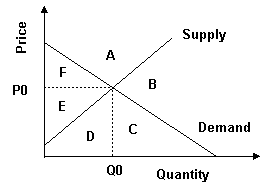
| 1. |
The Industrial Revolution:
|
| 2. |
(Repeat answer on Scantron lines 26, 27 and 28.) As stated in lecture, if we wish to be completely accurate, the law of demand states that:
|
| 3. |
According to Adam Smith, trade based on comparative advantage is the result of:
|
| 4. |
(Repeat answer on Scantron lines 29 and 30.) On which of the following does the federal government spend the smallest amount?
|
| 5. |
In capitalism, compared to mercantilism:
|
| 6. |
(Repeat answer on Scantron lines 31 and 32.) A(n) ________ is good which if supplied to one person must be supplied to all and whose consumption by one individual does not prevent its consumption by another individual.
|
| 7. |
One advantage of a corporation over a sole proprietorship is:
|
| 8. |
(Repeat answer on Scantron lines 33, 34 and 35.) An increase in the equilibrium quantity of personal computers and a decrease in their equilibrium price is most likely due to:
|
| 9. |
In theory socialism is an economic system
|
| 10. |
(Repeat answer on Scantron lines 36 and 37.) If there are many buyers and sellers in a market, the existence of a market surplus implies that price is:
|

| 11. |
(Repeat answer on Scantron lines 38 and 39.) Refer to the graph above. The arrow (or arrows) which most likely show a decrease in supply is (are):
|
| 12. |
One purpose of the IMF is to
|
| 13. |
(Repeat answer on Scantron line 40.) The ratio of U.S. imports to U.S. GDP is about
|
| 14. |
(Repeat answer on Scantron line 41.) What form of business is the most common in the United States?
|
| 15. |
When government attempts to adjust for the effect of decisions on third parties not taken into account by the decision makers, the government is attempting to
|
| 16. |
(Repeat answer on Scantron lines 42, 43 and 44.) Government's role in a market economy includes all of the following except:
|
| 17. |
Suppose a single firm gains control of an industry by preventing other firms from entering the industry. As a result, the price charged by the single firm is much higher than the price that would be charged by many different firms producing this product in a competitive market. This situation can best be described as:
|
| 18. |
(Repeat answer on Scantron line 45.) Which of the following would most likely generate a negative externality?
|
| 19. |
(Repeat answer on Scantron line 46.) The best example of a merit good or activity is:
|
| 20. |
Under feudalism,
|
| 21. |
The largest percentage of businesses are:
|
| 22. |
(Repeat answer on Scantron lines 47 and 48.) In the factor market:
|
| 23. |
In principle, __________ have ultimate control over the U.S. economy.
|
| 24. |
U.S. output represents about what percentage of total world output?
|

| 25. |
(Repeat answer on Scantron lines 49 and 50.) Referring to the above diagram of an initial market equilibrium, if equilibrium moved to somewhere in area E, we could be sure that:
|
Answer Key
| 1. | C |
| 2. | B |
| 3. | C |
| 4. | D |
| 5. | B |
| 6. | B |
| 7. | C |
| 8. | A |
| 9. | A |
| 10. | A |
| 11. | C |
| 12. | B |
| 13. | B |
| 14. | C |
| 15. | D |
| 16. | D |
| 17. | A |
| 18. | C |
| 19. | C |
| 20. | B |
| 21. | B |
| 22. | C |
| 23. | B |
| 24. | C |
| 25. | B |